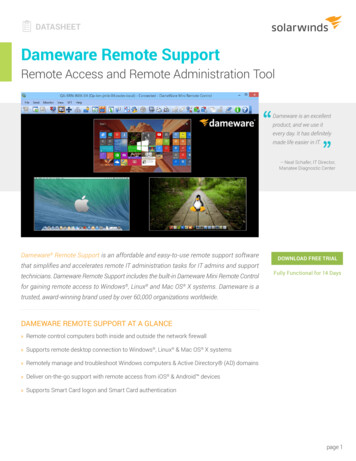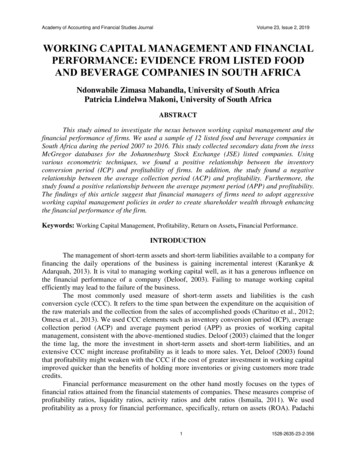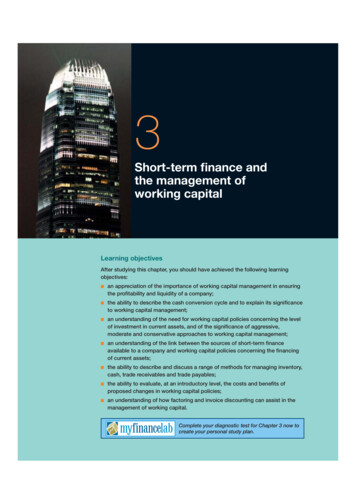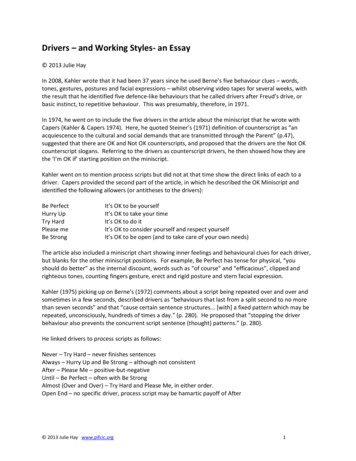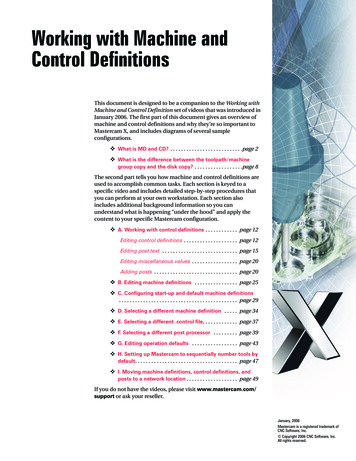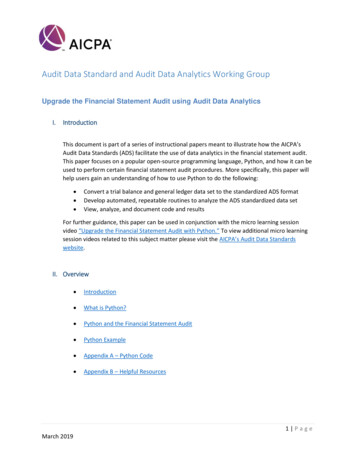
Transcription
Remote Workingand the Platformof the FutureOctober 2020By José Ferreira, Pablo Claver, Pedro Pereira, and Sebastião Thomaz
Boston Consulting Group partners with leadersin business and society to tackle their mostimportant challenges and capture their greatestopportunities. BCG was the pioneer in businessstrategy when it was founded in 1963. Today, wehelp clients with total transformation—inspiringcomplex change, enabling organizations to grow,building competitive advantage, and drivingbottom-line impact.To succeed, organizations must blend digital andhuman capabilities. Our diverse, global teamsbring deep industry and functional expertiseand a range of perspectives to spark change.BCG delivers solutions through leading-edgemanagement consulting along with technologyand design, corporate and digital ventures—and business purpose. We work in a uniquelycollaborative model across the firm andthroughout all levels of the client organization,generating results that allow our clients to thrive.
Contents01 Executive Summary17 The Journey to the HybridFuture02 The Point of No Return04 The State of the RemoteWorking Art The COVID-19 Experiment The Future of Work Is Hybrid08 The Hybrid Value Proposition A Source of Value for Companies The Employee Benefit A Force for Good in Society14 Four Unique Challenges The Threat to Productivity A Loss of Team Spirit The Onboarding Challenge Slowing Innovation Defining the Vision Designing the Hybrid Model Changing the PerformanceManagement Paradigm Implementing Agile Practices Developing the Caring Remote Leader Building the Technological Foundationsand Solutions33 Gaining Maturity Measuring Maturity Success Factors38 Moving Forward
Executive SummaryThe COVID-19 pandemic has prompted a vast, sudden, and unforeseen global experiment in remote work. In the face of governmentlockdowns and social distancing protocols, companies aroundthe world sent employees out of the office. In fact, nearly 80% ofwhite-collar employees have worked remotely at some point sincethe beginning of the pandemic.To date, the results have been positive. More than 40% ofmanagers report that productivity has actually increasedamong their remote workforce, and a similar percentagebelieves their overhead costs will decline. Employees havealso seen benefits, including a greater focus on the task athand, increased flexibility in their working hours, and asignificant improvement in their work-life balance. Societyas a whole benefits, too, thanks to the potential for greaterworkplace diversity, income equality, and environmentalsustainability.These insights come from a survey on the future of work,recently conducted with thousands of managers and employees in companies across Europe. Our survey found thatdespite their recent experiences, the large majority ofEuropean companies have a considerable amount of workto do to gain the full benefits of remote work. Their successwill depend on seven key factors, including a transparentremote-working vision, selecting the right operating models, promoting trust-based management, and establishingthe technological foundations and solutions needed.Yet this unexpected shift has not been without challenges.Managers worry that remote working can lead to a loss ofcontrol over employees’ activities and say it makes ensuring team engagement more difficult. Furthermore, someemployees say they struggle to maintain a sustainablework-life balance if not managed carefully, and many lackthe adequate training and tools necessary to work outsidethe office efficiently.In this report, we delve deep into the results of our surveyand offer detailed suggestions for ensuring that managersand employees alike succeed in working remotely. After all,the managers we surveyed expect almost half of theirworkforce to continue to work remotely to some degreeeven after the pandemic subsides. It is our sincerest hopethat the insights, recommendations, and solutions offeredin this report will help guide companies in their journey tothe hybrid future, ensuring they thrive in and come out asleaders of the new reality.1 REMOTE WORKING AND THE PLATFORM OF THE FUTURE
The Point ofNo ReturnIn February, the World Health Organization declared thecoronavirus a pandemic, changing the nature of workimmediately, and perhaps forever. With governmentsacross the globe mandating lockdowns and social distancing rules, companies closed their offices, people everywhere were forced to stay home, and the world embarkedon an unprecedented remote work experiment.The speed and extent of the shift to remote work has beenstartling. In Europe, almost 80% of office workers havebeen working from home since the beginning of the pandemic, up from less than 20% prior to the crisis. As thepandemic subsides, many workers will likely return to theiroffices in some form, yet these past months have undoubtedly marked a turning point in the future of work.BOSTON CONSULTING GROUP 2
The “new normal” has shown companies, employees, andsociety at large that the broader use of remote working isnot only possible but beneficial, if done right. Some companies will insist that all their employees return to theoffice; others will allow everyone to work remotely. Themost probable outcome of the pandemic-enforced experiment in remote working, however, is likely to be a hybridmodel, which at its best will combine the virtues of both.There will be a long-term adjustment to how wethink about our employee location strategy. 3 – CEO of a leading British bankTo better understand how organizations are shaping—andbeing shaped by—the sudden shift to remote working,BCG surveyed, in collaboration with KRC Research, morethan 1,500 managers and 7,500 white- and blue-collaremployees across 15 European countries in a broad rangeof industries, and interviewed numerous European business leaders at major companies. This Future of WorkSurvey allowed us to assess how remote working hasevolved in recent years and is likely to evolve in light of thepandemic; examine the motivations of business leadersand the challenges they face; and map the journey to therobust hybrid working platform of the future.REMOTE WORKING AND THE PLATFORM OF THE FUTURE
The State ofthe RemoteWorking ArtRemote working has been around for over 50 years,yet despite advances in the tools and technology thatenable it, its adoption has been limited and slowuntil very recently.The idea of remote work with the aid of digital technologydates to 1973, when Jack Nilles of NASA, using a telecommunications system to work from home, coined the term“telecommuting.”The use of such systems to work remotely, however, grewslowly prior to the pandemic, accounting for just 16% ofthe working time of the average European white-collarworker, according to our survey. Indeed, a large proportionof employees did not have access to remote work at all—nearly 80% of white-collar employees did not work remotely prior to COVID-19.11. A respondent is considered to be working remotely if she/he reports spending one day or more per week working somewhere other than thephysical office.BOSTON CONSULTING GROUP 4
Historically, media, telecommunications, and technologycompanies have been at the forefront of the remoteworking movement, largely to win the “war for talent,”especially in highly competitive jobs such as softwaredevelopment and research and development. Remoteworking spread slowly to other sectors with similar challenges, including finance and energy, and particularly inknowledge-intensive occupations. (See Exhibit 1.)As a result, nearly 80% of white-collar employees haveworked remotely at some point since the beginning of thepandemic. The number of workers in operations andcustomer-facing roles, jobs traditionally carried out almostexclusively onsite, who were sent home at least one day aweek more than doubled. Overall, the amount of timeEuropean workers of all types have spent working remotelyhas tripled.Before COVID-19, the share of time employees spent working remotely also varied widely across European countries.Denmark and the UK led the movement, followed by theNetherlands and Belgium. (See Exhibit 2.)In short, the pandemic has been the greatest catalyst forremote work in history.The COVID-19 ExperimentWhile it is unlikely that employees will continue to workoutside the office to the extent they’ve been forced to sincethe onset of the coronavirus, our survey shows that thepandemic will transform the nature of work permanently.Most companies will likely move to a hybrid model of work,partly remote and partly in the office. Remote working isnot without real challenges—managerial, operational, andtechnological—but our research suggests that the benefits,for managers and workers alike, outweigh the drawbacks,and the comfort level with hybrid working will improve withexperience.With the onset of the pandemic, the nature of workchanged swiftly. To control the spread of the coronavirus,most European governments implemented a range ofstringent contingency measures, including lockdowns,stay-at-home orders, and social distancing measures. Insome countries, hospitality-related businesses and restaurants were ordered to close down completely. Despitevarying degrees of success, the message was clear: everyone who could stay at home, should. To ensure businesscontinuity, virtually every company was forced to deploy avariety of work-from-home policies.The Future of Work Is HybridExhibit 1 - Media, Telcos, and Tech Companies Lead in Adoption ofRemote WorkTime European employees worked remotely, pre-COVID-19, by industry ergyFinancial inst.and insuranceConsumer goods15Health care14Public sector1413Industrial goods0%10%20%30%Sources: KRC; BCG analysis.Note: Includes white-collar roles (i.e., not in operations or customer service roles) working remotely at least one day per week.5 REMOTE WORKING AND THE PLATFORM OF THE FUTURE
Exhibit 2 - Denmark, the UK, and the Netherlands Are at the Forefront ofRemote WorkTime European employees worked remotely pre-COVID-19, by country Sources: KRC; BCG analysis.Note: Includes white-collar roles (i.e., not in operations or customer-service roles) working fully or partially remotely.65%BOSTON CONSULTING GROUP Management expects 65% of theworkforce to follow a partially hybridremote model after COVID-19, ofwhich 18% are expected to be fullyremote6
According to our findings, managers and employees agreethat remote work is here to stay. Overall, managers expectthat almost half of their workforce will work in a hybridremote model in the future, and an additional 18% willwork fully remotely. Half of all surveyed employees expectto have remote-working options once the pandemic subsides, rising to two-thirds among white-collar workers.Employees enjoy the increased flexibility remote workingoffers and how it accommodates their family and personalneeds. At the same time, however, they report difficultiesmaintaining cohesion among teams and other culturalaspects of working.We may never return to working as we did before.Client and employee behavior has changed inlasting ways. – CEO of a global bank7 Given the expectations of managers and employees for thefuture of work, key questions remain for business leadersseeking to capture the maximum benefits of hybrid working. What will the future of work look like? What value can be unlocked by enabling a hybrid ofremote and onsite work models? What are the main challenges to overcome? How should a remote-working platform be set up tosupport the transformation to hybrid work?REMOTE WORKING AND THE PLATFORM OF THE FUTURE
The HybridValuePropositionWhile the exact nature of the future of work remains uncertain, the results of our survey showthat a hybrid model, if implemented correctly, cancreate a “win-win-win” for companies, their employees, andsociety at large. Balance is a key success factor, as thisvision of working will be sustainable only if all three partiesbenefit from it.A Source of Value for CompaniesThe results of our survey indicate that managers foreseethree main benefits to remote working. Just over half expect cost savings, 43% expect improvements to talentattraction and retention, and 42% expect productivityincreases.BOSTON CONSULTING GROUP 8
Cost Savings. Among the key benefits—and long a factorin promoting remote work—is the potential for reductionsin office space and, thus, overhead costs. More than 40% ofmanagers expect a reduction in overhead costs, and 40%of them expect reductions of over 20%.Savings will come from the need for fewer individual workspaces, as companies adopt hot-desking policies. At thesame time, other types of office space, such as social andlearning spaces or meeting spaces to promote collaboration between remote and onsite workers, may increase, ifto a lesser extent. Some companies may choose to redesign their office footprint, moving office space to smallersatellite locations. Besides increasing flexibility and convenience for employees, this model could also offer savings ifthese new workspaces are located in lower-cost areas.More than half of managers also expect remote-workingpolicies to deliver payroll savings, primarily by adjustingcompensation to account for where remote employees arelocated.People now perceive remote work as an employeeright.– Head of a Spanish multinationalfood companyThe War for Talent. Our survey suggests that remoteworking can be a key driver for recruiting talent and reducing attrition among workers. During pandemic-enforcedlockdowns, employees experienced firsthand the benefitsof remote work, such as less commuting. Many becameaccustomed to the advantages of this new way of workingand will likely keep demanding flexibility in the future.Indeed, about hal
There will be a long-term adjustment to how we think about our employee location strategy. – CEO of a leading British bank To better understand how organizations are shaping—and being shaped by—the sudden shift to remote working, BCG surveyed, in collaboration with KRC Research, more than 1,500 managers and 7,500 white- and blue-collar employees across 15 European countries in a broad .
